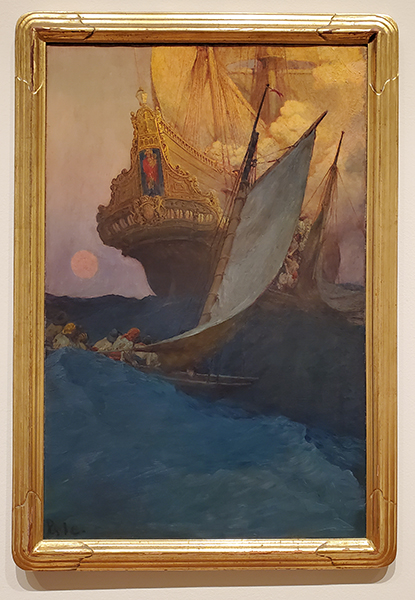Today we’ll begin a two-part series that explores pirates and other American illustrations from museums in the Brandywine River Valley. There is, of course, much more at each museum than what I will cover—a luminous George Inness, for example (Early Autumn, Montclair)—but if we are to be honest, my primary purpose for visiting these museums was to see the pirate paintings.
“Arr yawl” ready to “sea” some, too? (Forgive me for resurrecting that salty pun from the prior post.) Let’s jump in.
Voici le Brandywine.

Now jump! (Just kidding.)
All photographs in this post were taken by me.
Illustrations by Howard Pyle
First I visited the Delaware Art Museum. Originally the Wilmington Society of the Fine Arts, the museum was created to preserve the works and legacy of Howard Pyle, a Wilmington native and leading American illustrator. Over time, the collection expanded to include much art connected to the area, Pre-Raphaelite art, and American illustration.
Pyle taught locally and eventually opened his own art school. He instructed a generation of American artists and illustrators, known as the Brandywine School, among them Frank Schoonover and N. C. Wyeth. About half of his students were women. Pyle also wrote and produced books, such as The Merry Adventures of Robin Hood.
His pirate illustrations, among others, garnered significant attention, and it is to these that society’s romanticized vision of pirates is largely indebted. One could rather safely say the look of every popular buccaneer from Captain Blood to Captain Jack was influenced, directly or indirectly, by Pyle’s paintings. Pyle combined historical clothing articles, props, and other objects to create exotic but realistic figures such as this fellow.

I have seen this painting many times, but not until recently did it occur to me that this painting could also have influenced the design (again, directly or indirectly) of Red-haired Shanks from the long-running pirate manga One Piece. 26 years and still going!(!!) I can hardly imagine plotting & drawing the same story for that long.

Obviously this is not colorized, but his sash is red like the picturesque fellow’s.
Here are some lessons from Pyle:
On selecting what of the story to illustrate: “In painting we can only picture the supreme moment, leaving to the imagination what precedes and follows.”
He also had much to say on creating effective & engaging compositions. Space, color, and what I would call dynamic lines all can draw attention to key elements. Of space in particular, he advised not to crowd an image: “They will never shoot you for what you leave out of a picture.”
I think An Attack on a Galleon is a good example of some of these principles.

There are details, but nothing superfluous. Note the layered placement of the ships on two different waves/two different parts of the painting ground/picture plane and their size difference. These heighten the drama. I enjoy the rich colors.
Another case of influence: compare Galleon to the opening of Disney’s Treasure Planet.


With painting as with writing, revision is useful. Both these paintings are titled Marooned. Both are excellent (despite the glare on the book page on the first), but the second one is more striking and conveys the concept even better than the first.


The first painting seems more focused on the buccaneer, and the second on the concept overall. By changing the perspective, Pyle heightens the sense of isolation and barrenness. He reduces the horizon line to just a spit of wave and the water line to a little sea foam receding in the corner. There’s no offing to scan for ships or look out upon with a speck of hope. Everything is suspended at that moment, like there is nothing beyond that stretch of sand and the desolation of isolation.
Here’s a close-up.

Pyle spoke against crowding an image, but that does not mean he did not paint crowds. Here, a different kind of piracy may well have been afoot: The Rush from the New York Stock Exchange on September 18, 1873, from “A History of the Last Quarter Century.”

Other fun from the visit
Cartoonist Al Capp’s (Li’l Abner) description of modern art: “A product of the untalented, sold by the unprincipled to the utterly bewildered.” Ha. There are exceptions, but that covers a lot!
In the Divine Comedy, Dante and Virgil’s journey begins with a descent into hell.

Or NYC. This is Dante & Virgil in Union Square by Isabel Bishop.
Outfitting the C. [Charles] W. Morgan by Clifford Warren Ashley for his book Yankee Whaler.

This was a pleasure to see. I spent a significant part of childhood in Mystic, Connecticut, and I have walked the decks of the Morgan many times at Mystic Seaport.
So I don’t go overboard with sharing more artwork, that’s all for today. Part two will cover my trip to the Brandywine River Museum of Art in Chadds Ford, Pennsylvania.

Hi, Genevieve,
Thanks for the photos and some art history and technique lessons.
Voici le Brandywine reminds me of our junket northbound in the Great Dismal swamp in 1994.
Pyle’s paintings definitely contributed to our collective, idealized, impression of pirates.
The other works in this missive are interesting. I had to chuckle at Dante & Virgil…
Good to see the Morgan again, even without the sounds of rigging, salt air, and waves lapping its hull.
Thanks for giving us some water in which to dangle our feet while we wait for part-two.
Lots of love,
Dad
Genevieve
Thanks for this post.
Attack on the Galleon was useful for me—handling of water.
Nice you could see some of these works in the flesh
/
All best
David
Hi, David. Thanks for sharing. It’s an instructive painting.
Good to hear from you.
Genevieve
You’re welcome. Glad you enjoyed.